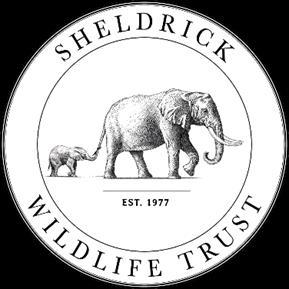
SWT/KWS RIFT VALLEY MOBILE VETERINARY UNIT
APRIL 2024



14 Cases in April 1 Rhino Case
April Report by
Dr. Titus Kaitho
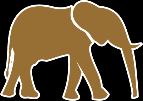
The Lake Naivasha Area and Central Rift Conservation Area in general received heavy rainfall in April 2024. Fourteen (14) cases were attended to by the SWT/KWS Rift Valley Mobile Veterinary Unit.
This included 2 postmortem examinations, one involving an elephant calf that was found to have died from natural causes while the other involved an adult male black rhino that was found to have died from territorial fight wounds. The team also attended to 3 predator cases, the first 2 involved surgical procedures on a captive lioness named Makoma on separate dates while the other involved examining and ear notching a leopard that was captured in a predator free area 2 Masai giraffe were treated over the reporting period, one giraffe had a severe wound on the forelimb caused by a wooden splint while the other was snared. The team also attended to 3 common zebra poaching cases. Sadly, one of these animals was put to rest to alleviate further pain and suffering given the severity of its injuries Tragically, 1 adult male waterbuck was paralyzed in a territorial fight was also euthanized. In a separate case, another adult male waterbuck was relocated to Hell’s Gate National Park after it knocked down a worker at Sopa Lodge. The veterinary team also performed a rapid assessment for the possible translocation of 2 hippopotami residing in Malewa dam after KWS received reports that the animals were raiding crops in the area. Lastly, the veterinary team assessed the performance and suitability for service of 4 KWS security dogs
Acknowledgement
The Rift Valley Mobile Veterinary team greatly appreciates The Brady Hunter Foundation for funding the Unit through the Sheldrick Wildlife Trust (SWT). The team acknowledges Angela Sheldrick, CEO -SWT for her unwavering support and interest in the work undertaken by the Mobile Veterinary Unit and thanks the Wildlife Research & Training Institute (WRTI) for hosting the Unit at WRTI - Naivasha. The team additionally thanks all the stakeholders and scouts who reported wildlife in distress and supported the veterinary interventions captured in this report. Thank you all.
Introduction
1 Elephant Case
Case Details
08-Apr 24 Security Dog WRTI Annex Technical Case Performance and suitability of service assessment of 4 security dogs Task successful
13-Apr 24 Lion Poa Place, Eldoret Natural Causes Makoma, a captive adult female lion, had closed pyometra causing severe toxemia Successfully treated
14-Apr 24 Elephant Marigat Baringo Postmortem
15-Apr 24 Zebra Naivasha Snared
15-Apr 24 Zebra Bilashaka, Naivasha Poaching
Autopsy on the carcass of a 1-month-old male elephant calf Died. Cardiac malfunction
Adult female zebra with a wire snare on the left front limb Successfully treated
Lame adult male zebra with its tendon on the left hind leg severed by a sharp object Poaching Death
16-Apr 24 Lion Poa Place, Eldoret Natural Causes Surgical intervention to replace sutures after Makoma’s opened her surgical wound Prognosis poor
17-Apr 24 Waterbuck Sopa Lodge, Naivasha HWC
19-Apr 24 Zebra Police Lines, Naivasha Snared
20-Apr 24 Rhino Lake Nakuru N.P. Postmortem
22-Apr 24 Leopard Marula, Naivasha HWC
22-Apr 24 Giraffe Mundui, Naivasha
Relocation of an adult male waterbuck from Sopa Lodges to Hell’s Gate N.P Task successful
Adult male common zebra with wounds on the legs inflicted by snares Successfully treated
Autopsy on the carcass of a 26-year-old black rhino named Bor Died. Fight wounds
Examination and ear notching of a male leopard trapped in the predator free area Task Successful
Natural Causes Adult male Masai Giraffe wounded on the left front leg by a wooden splint Prognosis poor
23-Apr 24 Hippo Malewa Dam, Naivasha HWC
24-Apr 24 Waterbuck Naivasha Station Natural Causes
29-Apr 24 Giraffe Hell’s Gate N.P. Snared
Rapid assessment for possible translocation of 2 hippopotami residing in the dam. Task successful
Examination of an adult male waterbuck severely injured during a territorial fight Died. Euthanized
Adult female Masai giraffe with a long wire snare on the hind leg
Successfully treated
Reason for Intervention Outcome
Date Species Area Found
SWT/KWS Rift Valley Mobile Vet Unit Treatment Locations
April 2024
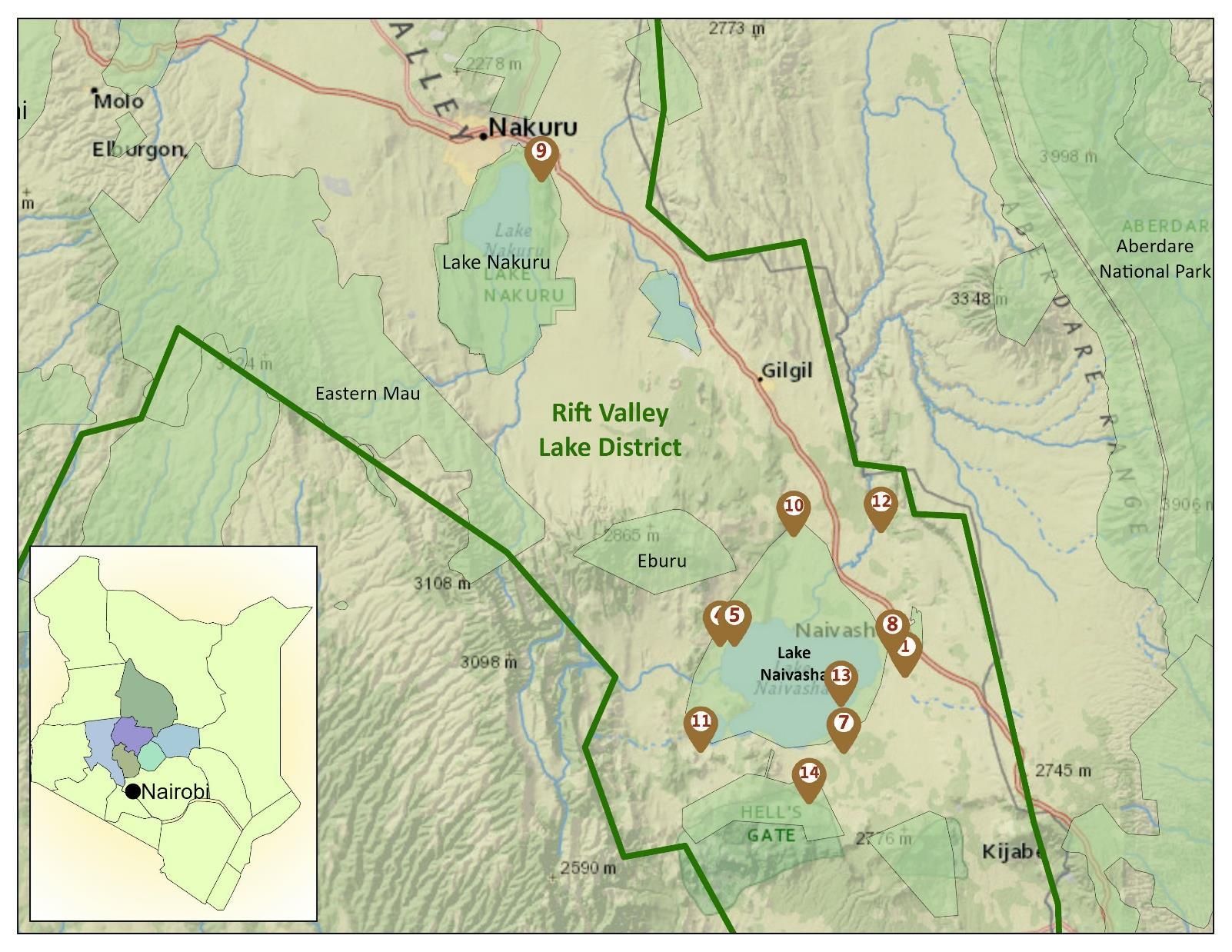

Security Dog
Technical Case JKIA East Gate Kennels & Mombasa Marine
From 08/04/2024 to 11/04/2024, Dr. Titus Kaitho, Elka Makhanu, Michael Ogwora (AWF), Florence Lepa and Patrick Musau evaluated the performance and suitability for service of four (4) canines at the Jomo Kenya International Airport/East Gate Kennels and Mombasa Marine.
Findings and
recommendations
Ricky, a 9-year-old male German Shephard, Belgian Malinois cross working as a sniffer/ detector dog had aged and lost some teeth. His performance was fair. The team determined that he could serve for a year before he is retired.
Roxy, an 8-year-old male Belgian Malinois had performed poorly as a sniffer dog. He had hip dysplasia and arthritis. The team recommended that he should be retired or put to rest.
Asja, a 9-year-old female Springer Spaniel had aged, but she was found to have performed fairly. The team recommended that she be replaced or retired on performance grounds.
Luna, a 2-year-old female Belgian Malinois had been assigned as a tracker dog. She was in good health, but she wasn’t trainable and lacked courage. The team found she was not useful to KWS and recommended that she be rehomed as a pet elsewhere.

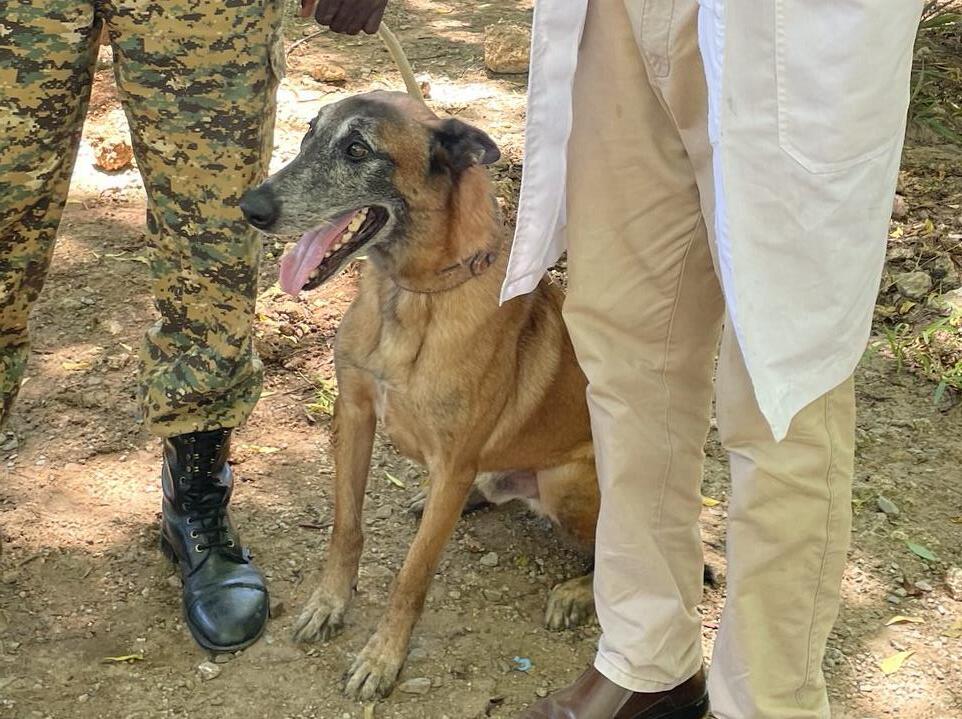
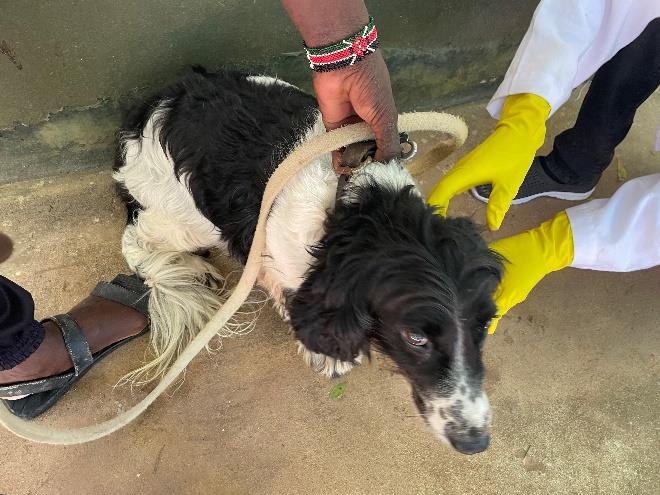

1 – 08th April
Case
2024
Lion
Natural Causes
Poa Place, Eldoret
At Poa Place Resort in Eldoret there are 3 lions held in captivity. 2 female lions and 1 male lion, who has been vasectomised, live in an enclosure On 13/04/2024, the Rift Valley Mobile Veterinary Unit examined an ill lioness, named Makoma, that had been anorexic for 3 days due to severe toxemia.
Immobilisation, examination and treatment
Makoma was darted with 280 mg Ketamine and 6 mg Medetomidine. She was fully anaesthetised after 10 minutes. Ultrasonography was undertaken and Makoma was found to be very positive for pyometra. She had 2 ovarian cysts on the left ovarian horn. Emergency ovariohysterectomy was performed to save her from fatal toxemia due to a closed pyometra. The skin was shaved and cleaned with Iodine. A surgical drape was placed on abdomen and a bold incision was made on the midline from the umbilical cord stump downwards. Skin, fascia, and abdominal muscles were cut then the omenta were exposed. The uterine horns were located, exteriorized, clamped, and ligated with chromic cat gut No 2. The cervix was located, clamped, and ligated with chromic cat gut suture. Haemorrhage was controlled by ligating any bleeder. The peritoneum was infused with Betamox antibiotic then the 3 layers of abdominal muscles were closed using Vicryl/Polyglactin 910 suture No 2 or 1. The muscles were infiltrated with Betamox antibiotic before the skin was apposed with Vicryl sutures and the sutures effectively buried into the skin. Oxytetracycline spray was then applied topically.
The surgical procedure was performed in 2 hours and 30 minutes. 150 mg Ketamine and 4 mg Medetomidine was administered intramuscularly after the first hour to top up anaesthesia 6,000 mg Amoxicillin and 40 ml Catasol were administered intramuscularly while 6 mg Dexamethasone and 1,500 mg Metronidazole were administered intravenously. 500 ml normal saline and 500 ml Ringer’s lactate were also administered intravenously and subcutaneously. Anaesthesia was reversed with 30 mg Atipamezole administered intramuscularly. The veterinarian advised that Betamox tablets and Meloxicam tablets be administered through the oral route/tablets hidden in meat for the subsequent 5 days.
Prognosis
The surgical procedure was successful, and the lioness was given a good prognosis.


Case 2 – 13th April 2024
Post-mortem
Muchogoi Area, Marigat
On 13/04/2024, KWS - Kabarnet Station reported an ill elephant calf. The calf was seen lying down at 1600 hrs and died soon thereafter. The matriarch elephant had borne twins, one was healthy and walking normally while the other was ill and immobile. On 14/04/2024, the SWT/KWS Rift Valley Mobile Veterinary Unit performed a postmortem examination on the carcass.
Post-mortem findings
The elephant calf was found in lateral recumbency. It was in fair body condition before death. Upon opening the carcass, petechiae, ecchymotic and paint brush haemorrhages were seen on the heart valves. There was petechiae and ecchymotic haemorrhages on the endothelial surface of the aortic arch. The omenta surface was heavily congested. Ulcerations and paint brush haemorrhages were seen on the stomach wall. Part of the colon was ulcerated and inflamed.
Cause of death
The elephant calf died from cardiac malfunction as result of severe thrombosis and severe enteritis.
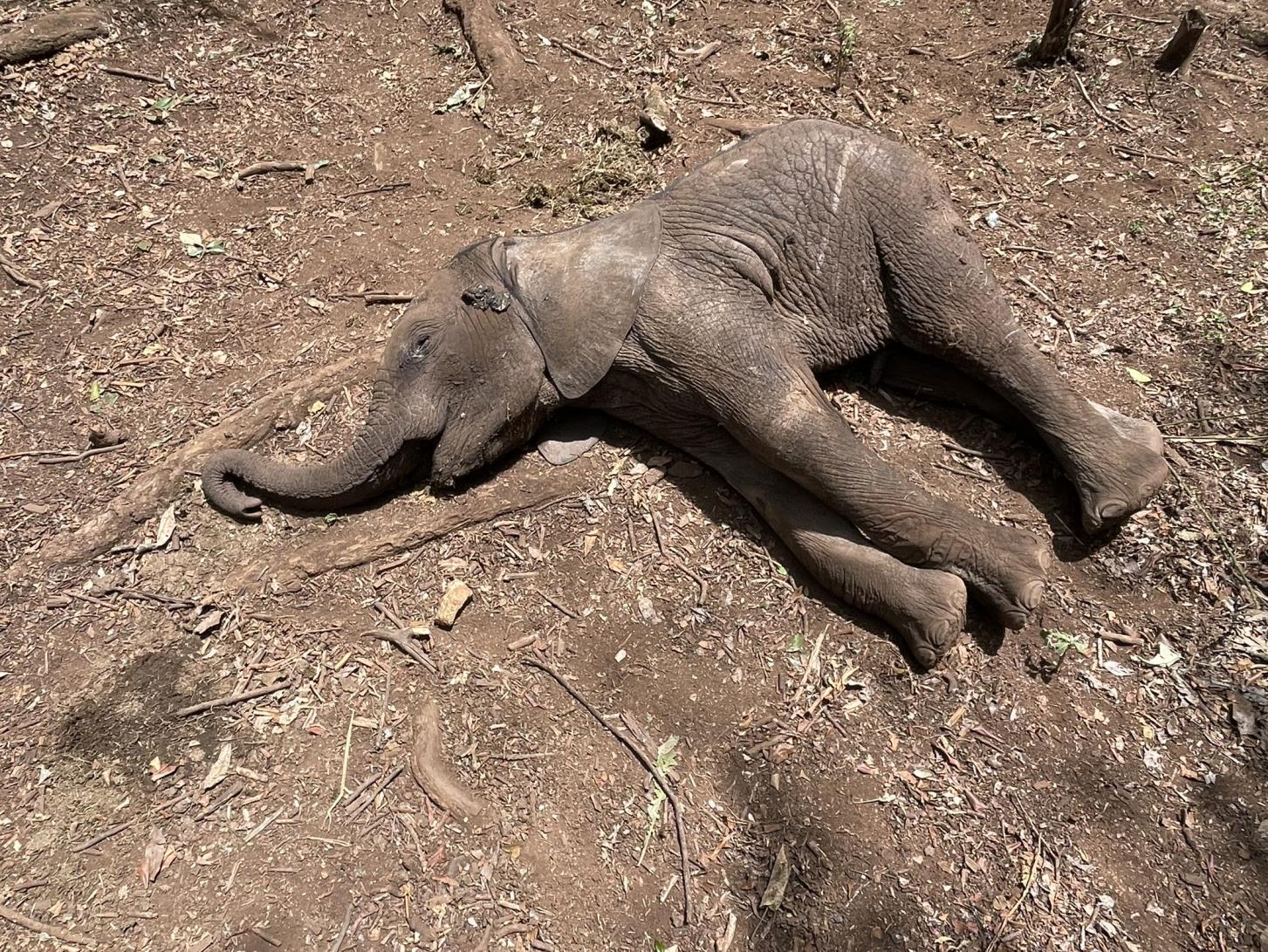
Case 3 – 14th April 2024 Elephant
Case
4 – 15th April 2024
Zebra Snared
Olerai Farm staff reported a snared adult female zebra.
Immobilisation, examination and treatment
Olerai – Olsuswa Area
The zebra had been tethered to a wooden pole by a wire snare. The animal was darted and immobilized with 5 mg Etorphine and 80 mg Azaperone.
Luckily, the zebra had only suffered minor bruises on the snared limb. The snare was removed then 250 mg Flunixin meglumine and 40 ml Catasol were administered intramuscularly. 5 ml Ivermectin was also administered subcutaneously before anaesthesia was reversed with 75 mg Naltrexone given intramuscularly and intravenously.
Prognosis
The zebra has a good prognosis.




Zebra Poaching
Olerai Farm staff reported an injured adult male common zebra.
Immobilisation, examination and treatment
The zebra was darted and immobilized with 5 mg Etorphine and 80 mg Azaperone.
Upon examination, the zebra was found to have a severed/ cut tendon on the left hind leg. This injury was most likely inflicted by sharp object, possibly a machete or a spear. Given that the zebra could not walk, it had a grave prognosis. Therefore, it was put to rest to alleviate further pain and suffering.
Prognosis
The zebra had a poor prognosis, it was put to rest to alleviate further pain and suffering.
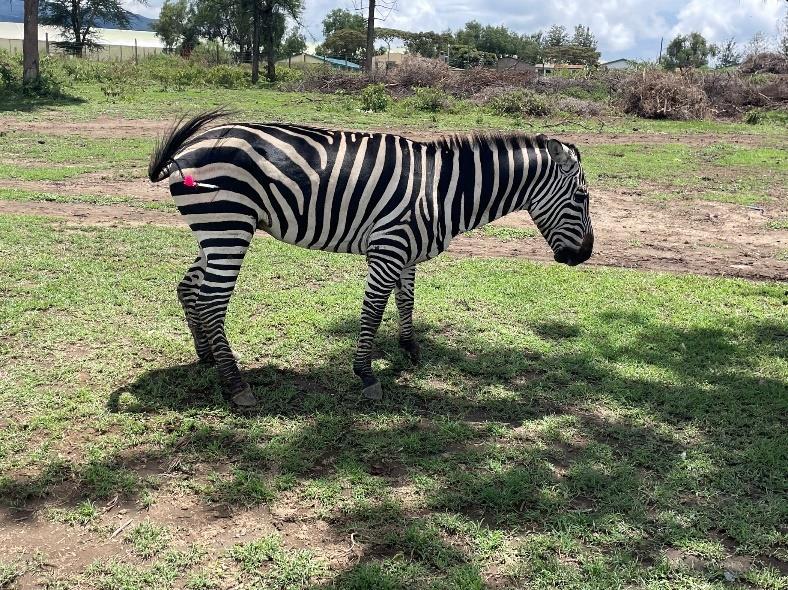
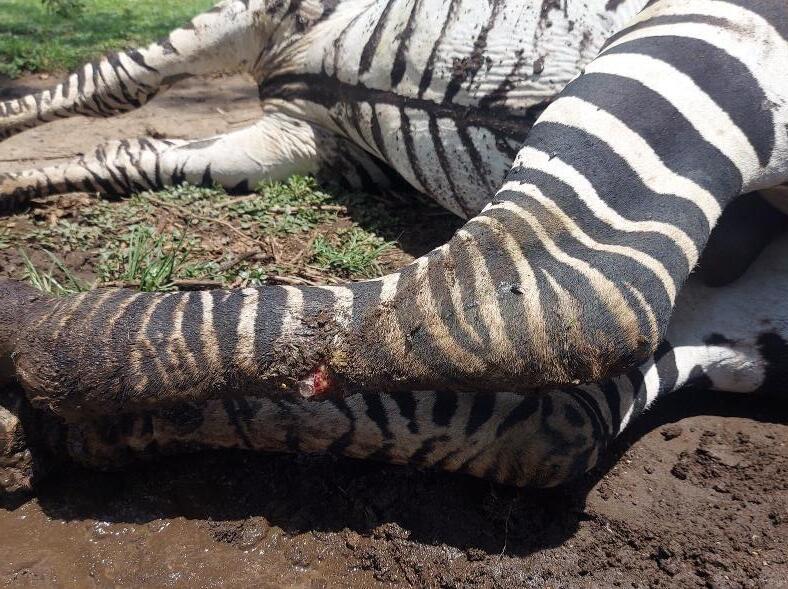

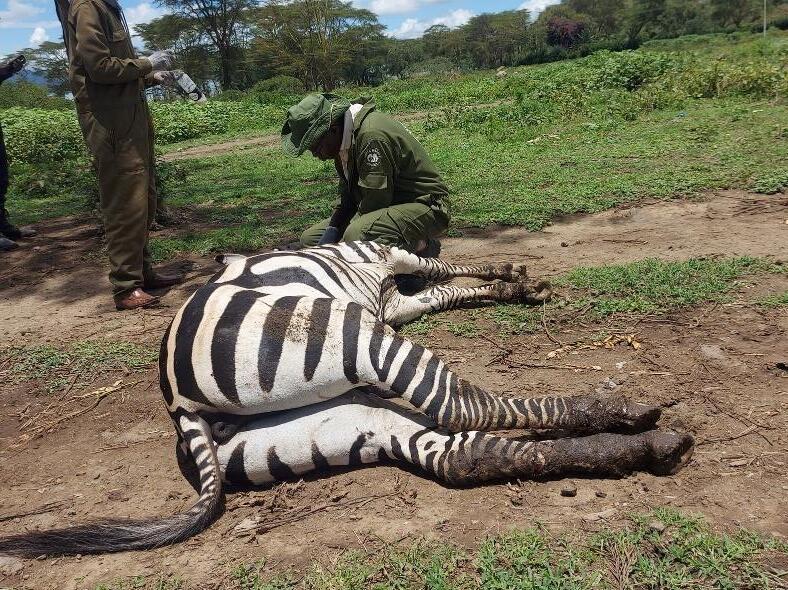
Case 5 – 15th April 2024
Bila Shaka Farm
Case 6 – 16th April 2024
Lion
Natural Causes
Poa Place, Eldoret
On 16/04/2024, the SWT/KWS Rift Valley Mobile Veterinary Unit performed surgery on Makoma to replace sutures on her surgical wound after she opened the wound exposing part of the omental fat.
Immobilisation, examination and treatment
Makoma was immobilized with 280 mg Ketamine and 6 mg Medetomidine. The lion was in deep anaesthesia after 8 minutes. After 1 hour, anaesthesia was topped up with 150 mg Ketamine and 4 mg Medetomidine. 6,000 mg Amoxicillin, 40 ml Catasol and 50 mg Meloxicam were administered intramuscularly, and 100 mg Meloxicam administered subcutaneously. The surgical site was cleaned with Iodine, contaminated omental and mesenteric fat cut off, and tissues cleaned with normal saline and infused with crystalline Penicillin. Muscles tissues were sutured with Polyglactin 910/Vicryl No 2 while the skin was sutured in a burying suture pattern with Vicryl No 1. Betamox and Crystalline Penicillin were infused into the muscles during closure of the wound. Oxytetracycline was sprayed on the skin post-surgery The surgical procedure took 2 hours.
Prognosis
Makoma has a guarded prognosis The team recommended close monitoring for at least 72 hours postsurgery to prevent her from opening of the sutured wound. Additionally, administration of Meloxicam and Betamox tablets hidden in meat for the subsequent 5 days was advised


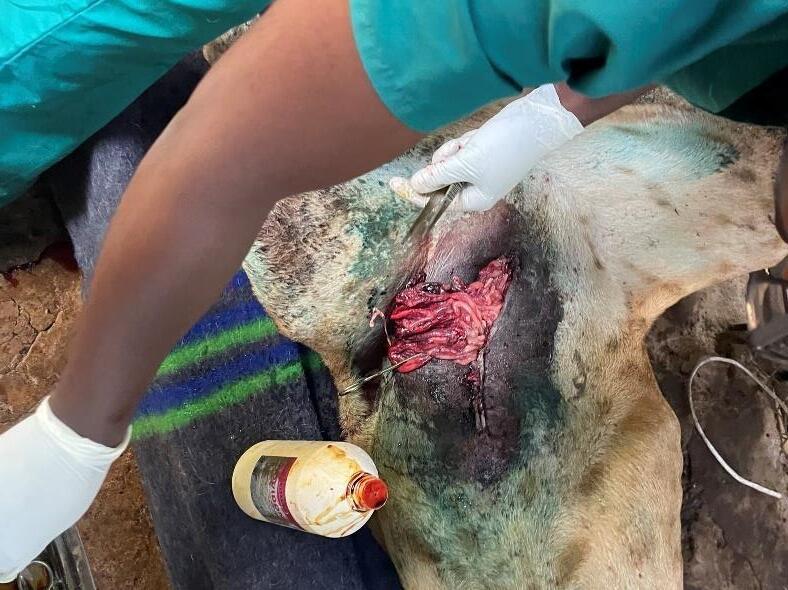

Case
Waterbuck
Human-wildlife conflict
Sopa Lodges, Naivasha
The SWT/KWS Rift Valley Mobile Veterinary Unit translocated an adult male waterbuck from Sopa Lodges to Hells Gate National Park. The animal had attacked a hotel worker and was a threat to visitors and staff at the facility.
Translocation
The request for translocation was made through the Senior Warden Naivasha Station and authorized by the Head of Veterinary & Capture services Department. Immobilization was achieved by darting the animal with 6 mg Etorphine and 60mg Azaperone.
The waterbuck was transported while it was under general anaesthesia from Sopa Lodge to Hell’s Gate National Park about 8Km away. Anaesthesia was reversed at the release site with 125mg Naltrexone given intravenously and intramuscularly to avoid re-narcotization.
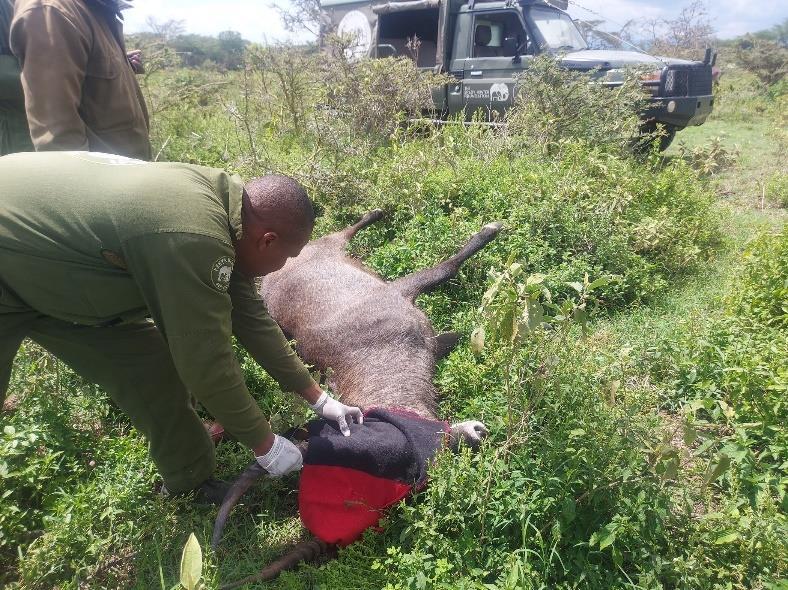
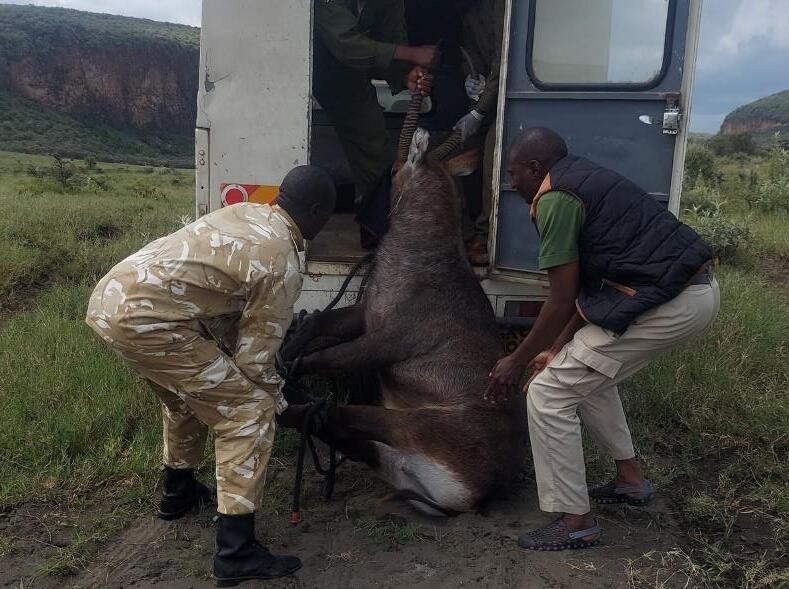
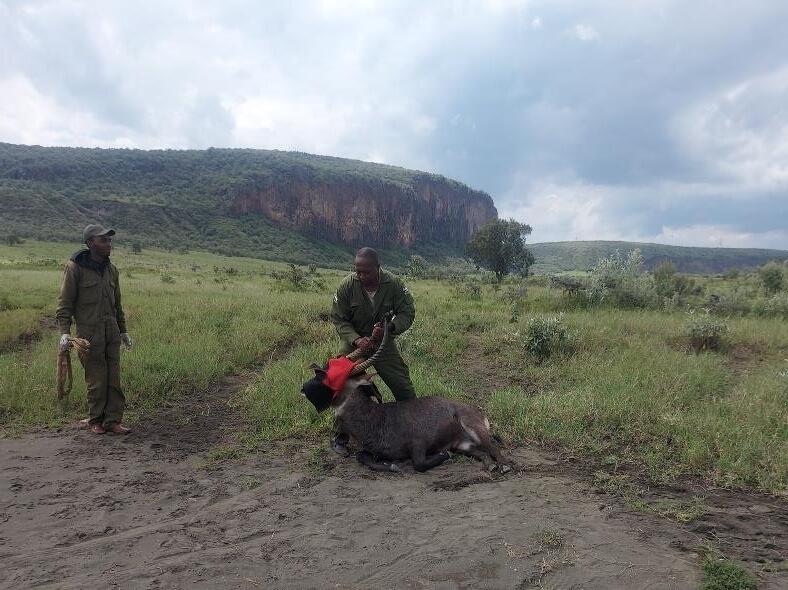

17th
7 –
April 2024
Zebra Snared
Naivasha Police Station reported a snared adult female common zebra
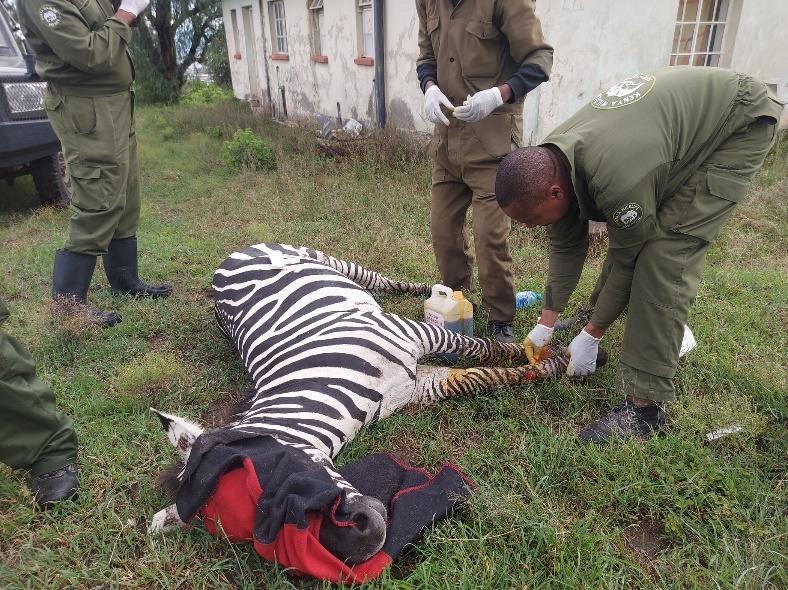
Immobilisation, examination and treatment
Naivasha Police Lines

The zebra was darted with 5 mg Etorphine and 80 mg Azaperone.
Upon examination, wounds inflicted by the snare were observed on the zebra’s legs The wounds were cleaned with water, rinsed with Iodine, and sprayed with a fly repellent (Alamycin® Aerosal). Additionally, 250 mg Flunixin meglumine 9,000 mg Amoxicillin, and 40 ml Catasol were administered intramuscularly while 5 ml Ivermectin was administered subcutaneously. Anaesthesia was reversed with 75 mg Naltrexone given by intramuscular and intravenous route.
Prognosis
The zebra has a good prognosis.

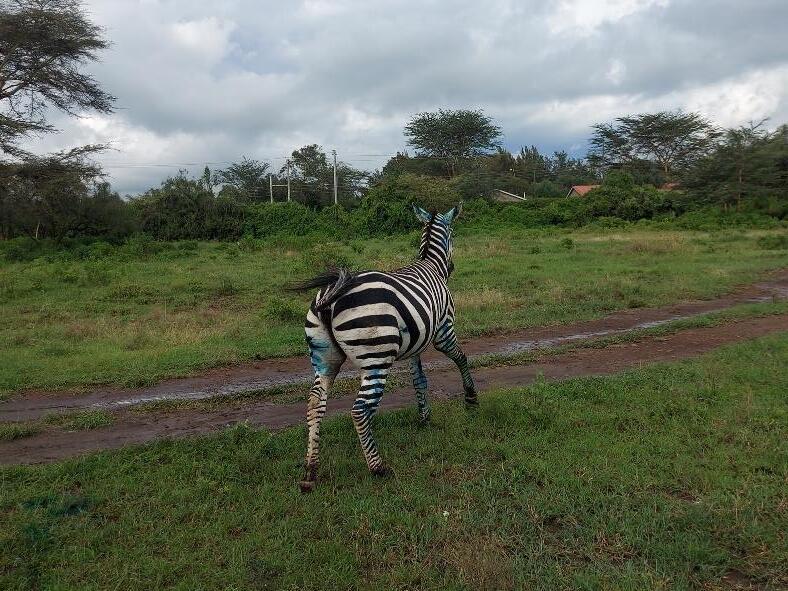
8
19th April 2024
Case
–
Lake Nakuru National Park management reported the death of a male black rhino named Bor. The rhino had been treated for territorial fight wounds on 17/04/2024.
Postmortem findings
The carcass was found in a quarry area near a watering pond. The rhino carcass was lying in supine position. The lower and upper horns were intact (present).
The rhino had been mauled by scavengers on the legs, neck, and chest area. The carcass was severely autolyzed/decomposed, and no expressive postmortem exam could be carried out. Second generation maggots were seen. The age of carcass was estimated to be four (4) days old.
Cause of death
Bor died from the natural progression of illness arising from severe injuries sustained during a territorial fight with another male rhino
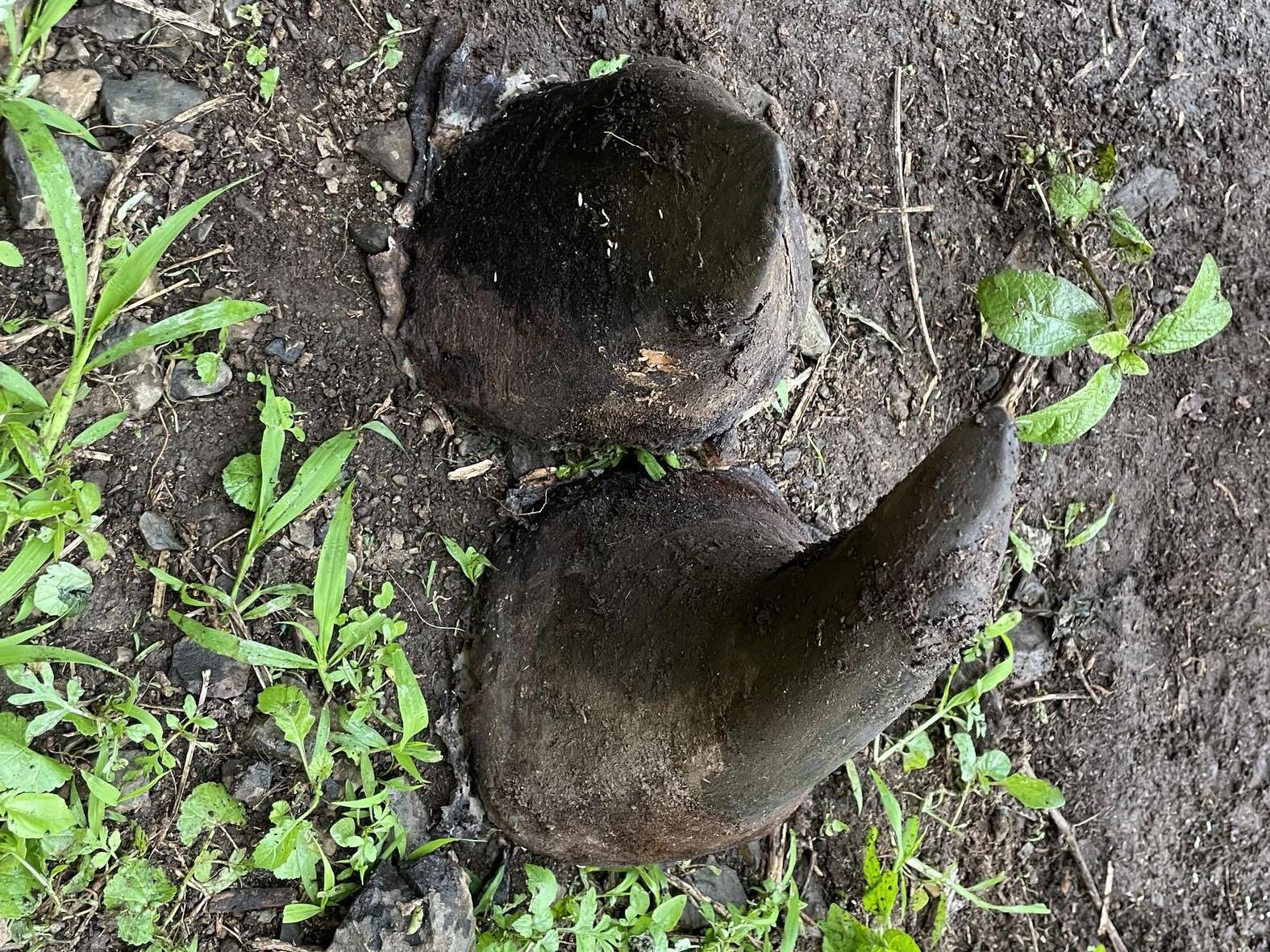
Case 9 – 20th April 2024 Rhino Postmortem
Mashimoni Area, Lake Nakuru N.P.
Case 10 – 22nd April 2024
Leopard Human – Wildlife Conflict
Marula
Estates
On 22/04/2024, the SWT/KWS Rift Valley Mobile Veterinary Unit examined an adult male leopard that had been trapped in Marula Estates. The male leopard was ear notched for identification purposes and later translocated to the wild.
Immobilisation, examination and treatment
The leopard was darted with 250 mg Ketamine and 3 mg Medetomidine. The animal had been trapped as it attempted to prey on gerenuks in the predator free Marula Estates.
Upon examination, the leopard was found to have suffered minor skin lacerations which were sprayed with a fly repellent (Alamycin® Aerosal). The leopard was ear notched for identification purposes. 1500 mg Amoxicillin was administered, and Frontline® spray applied on the animal’s skin to control ectoparasites infestation. Anaesthesia was reversed with 20mg Atipamezole given intramuscularly 1-hour postimmobilization.
Prognosis
The leopard has a good prognosis. The leopard was later translocated to the wild.
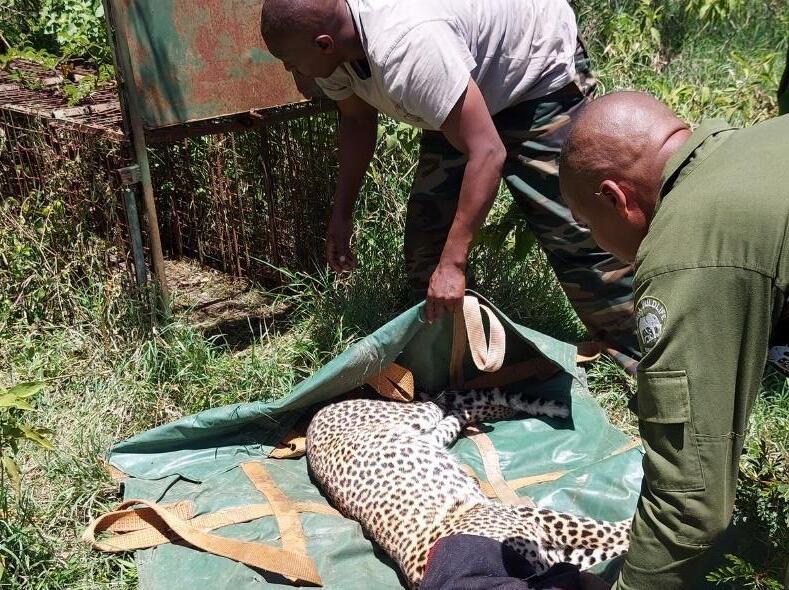


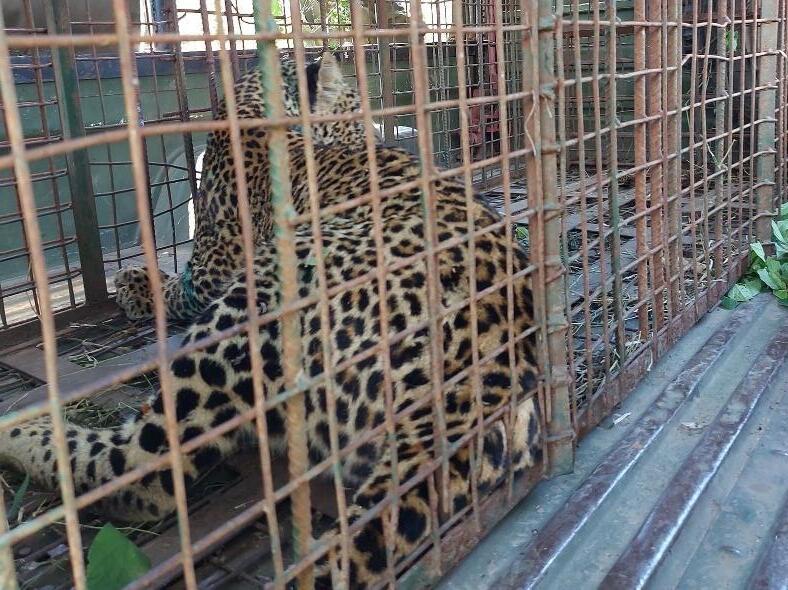
Giraffe Natural Causes
Mundui Estates
Mundui Estates management reported an adult male Masai giraffe wounded on the front limb.
Immobilisation, examination and treatment
This giraffe was darted with 15 mg Etorphine and 80 mg Azaperone.
Upon examination, it was determined that the giraffe was most likely wounded by a wooden splint. The wound was infected and suppurative. It was cleaned with water, rinsed with Iodine, and sprayed with a fly repellent (Alamycin® Aerosal). Additionally, 1,000mg Flunixin meglumine, 15,000mg Amoxicillin and 40ml Catasol were administered intramuscularly. 15ml Ivermectin was also administered subcutaneously. Anaesthesia was reversed with 225mg Naltrexone administered intravenously; a quarter of the dose was administered intramuscularly to avoid re-narcotization.
Prognosis
The giraffe has a guarded prognosis.
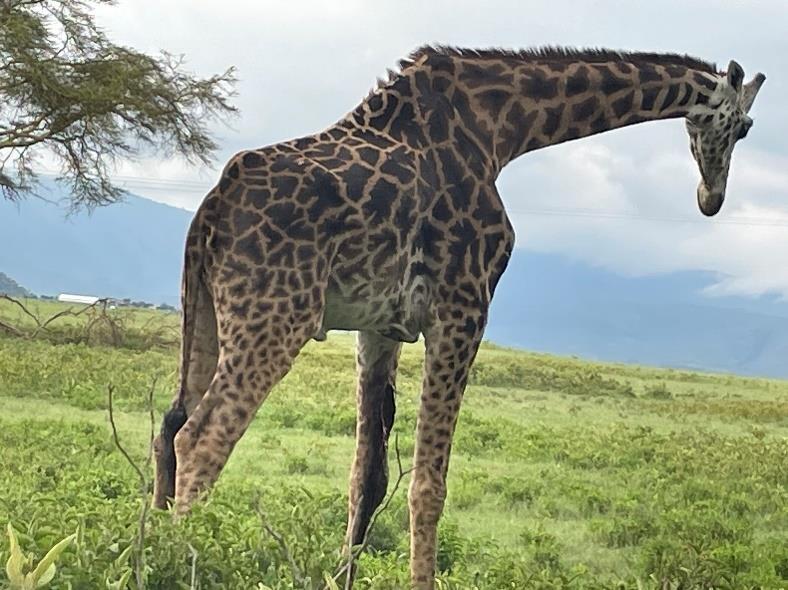



11 – 22nd April 2024
Case
Hippopotamus Human-Wildlife Conflict
Gatamaiyo Area, Malewa Dam
The SWT/KWS Rift Valley Mobile Veterinary Unit performed a rapid assessment in response to report of Hippopotami residing in Malewa Dam raiding farms in the Gatamaiyo area.
Findings and recommendations
There are two (2) hippopotami (mother and calf) living in Malewa Dam. The area is mountainous and has rugged terrain. Malewa Dam is a huge man-made dam (approx. 500 meters long X 300 meters wide). It was built to supply water to the nearby Aberdare golf course resort The dam is fed by the Malewa River which flows into Lake Naivasha. The dam is currently full, and water is flowing out of the spillway. The neighbouring area is cultivated by small scale farmers. Hippos invade the farms at night and hide in the dam during the day. Although the team was not able to spot the animals, farmers in the area confirmed seeing them in their farms. The 2 hippopotami can therefore be handled as PAC cases. Proper signage (in bold red colour) should be placed in all strategic points, and it should be very explicit about the fatal nature of hippo attacks. The presence of these animals in the dam should be well spelt out in the signage. Public education and awareness should be caried out. Local administration and the KWS community Warden(s) should team up to educate the public and trespassing should be prohibited. Herdsmen and fishermen should be made aware of the dangers of moving close to the hippos. Capturing and translocating the 2 hippopotami to a safe place requires significant resources and over 20 working days
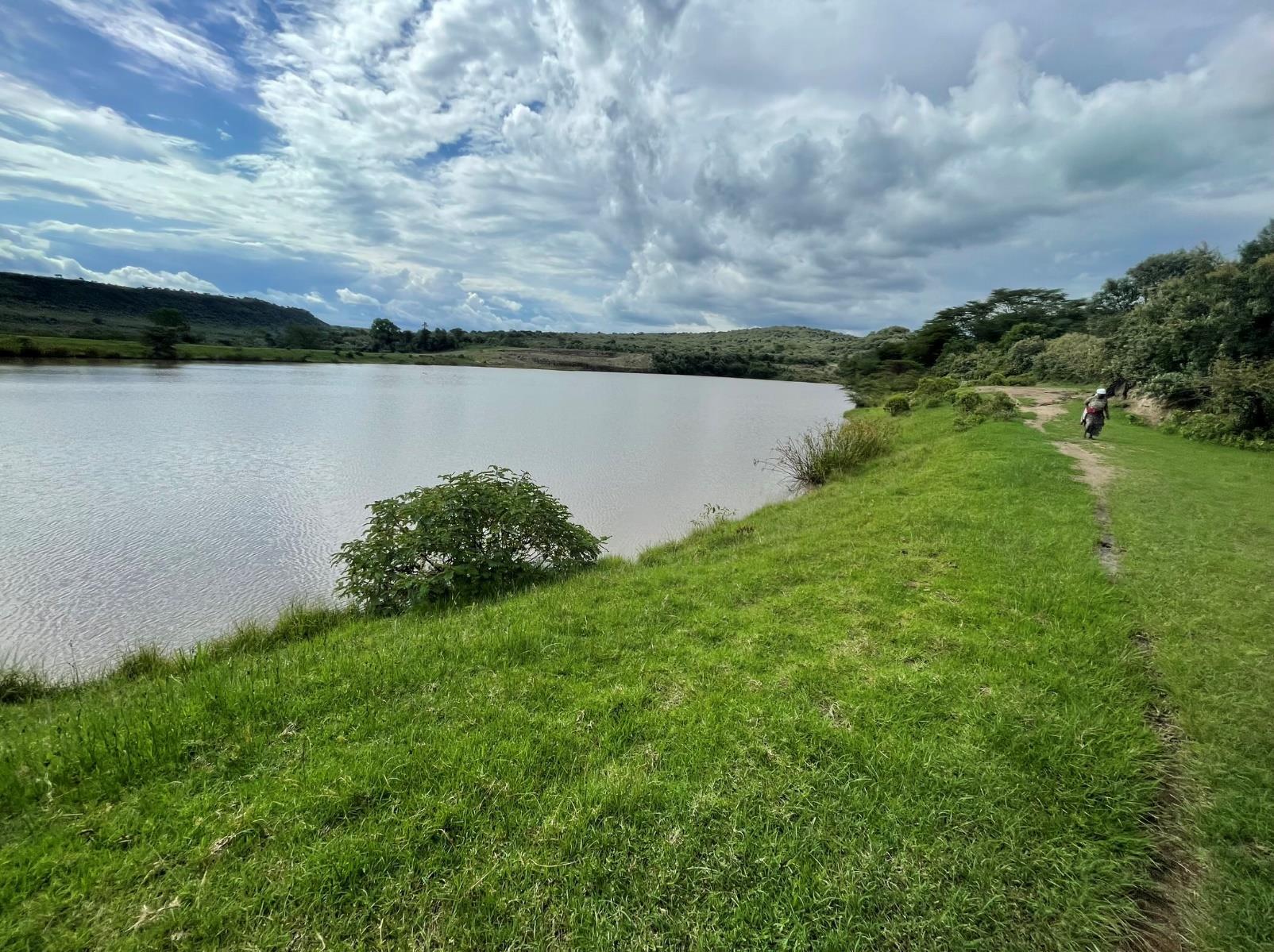
12 – 23rd April 2024
Case
Waterbuck Natural Causes
Naivasha Station
The SWT/KWS Rift Valley Mobile Veterinary Unit was informed about an injured adult male waterbuck
Immobilisation, examination and treatment
The water buck had been involved in a territorial fight with another male at Rumi Flowers. Unfortunately, the animal suffered a spinal cord injury that resulted in paralysis of the front and hind limbs. Puncture wounds were observed on the hind legs. The waterbuck had a poor prognosis. Therefore, it was put to rest to alleviate further pain and suffering.
Prognosis
The waterbuck had a poor prognosis and was put to rest to alleviate further pain and suffering

Case 13 – 24th April 2024
Hell’s Gate National Park management reported the sighting of an adult female Masai giraffe with a long wire snare on the hind leg.
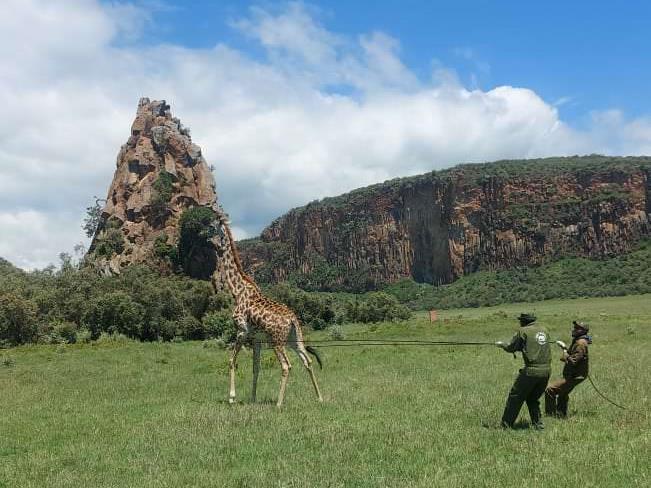

Immobilisation, examination and treatment
The snared giraffe was darted with 15mg Etorphine combined with 80mg Azaperone.
The giraffe was smoothly brought down when the drugs took effect. Fortunately, the snare had only inflicted minor skin laceration. The snare was removed then anaesthesia was promptly reversed with 225mg Naltrexone administered intravenously, a quarter of the dose was given intramuscularly to avoid renarcotization.
Prognosis
The giraffe has a good prognosis

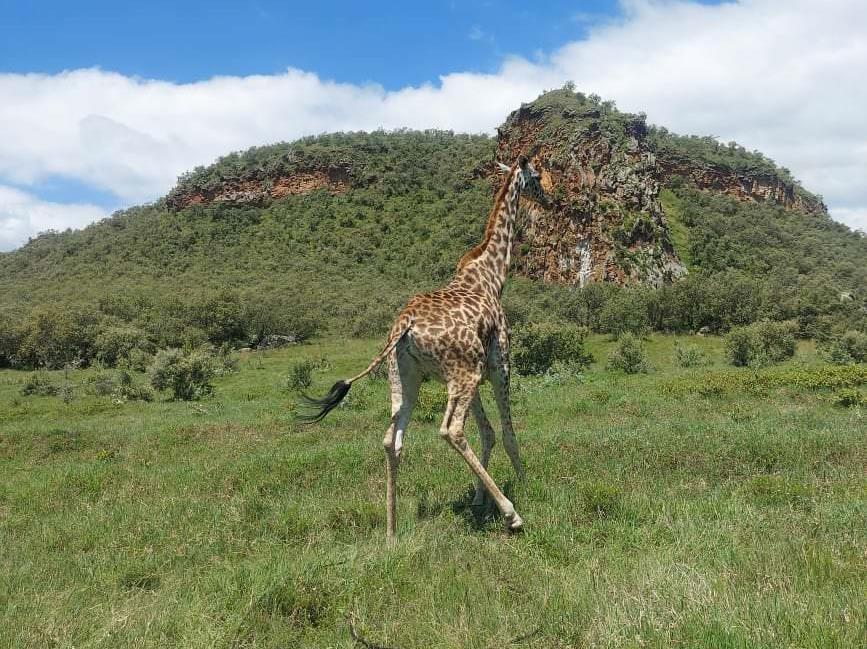
Case 14 – 29th April 2024
Giraffe
Snared
Kingfisher Area, Hell’s Gate N.P.

















































